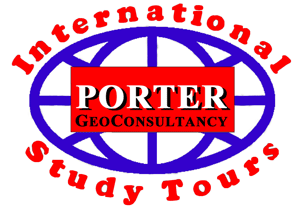| |||||||||||
| |||||||||||
| |||||||||||
 Highly Successful World Nickel Tour
Highly Successful World Nickel Tour
By Mike Porter The buoyant nickel price and renewed international exploration and acquisition interest in the metal contributed to the outstanding success of the latest of the AMF International Study Tours, Nickel 2000. This has been the most ambitious of the eleven tours in the continuing series run over the last three and a half years. It visited 18 of the most important nickel deposits in the world, both laterite and sulphide resources. The tour attracted support from virtually all of the world's significant nickel players, including WMC, Falconbridge, Inco, QNI-Billiton, SLN-Eramet, BHP, Anglo American, Rio Tinto, Centaur and Anglovaal. The 40 participants came from 10 countries in Australasia, North and South America, Africa, Asia and Europe, and ranged from field geologists to the Senior Vice President in charge of the worlds largest mineral exploration group. The tour ranged around the world, to seven countries on four continents, from the snow shrouded plateau of far northern Quebec, to the wastes of Arctic Siberia, the steamy tropical jungles of the Carribean, Colombia and New Caledonia to the deserts and arid lands of Australia and north-western China. The itinerary allowed for a variety of interests. Participants were able to take one or more of five different segments. The tour was structured so they could choose on a geographic basis between Australasia, the Americas or Eurasia, or alternatively concentrate on either deposits in an Archaean terrane, tropical laterites or post-Archaean sulphides. Several companies placed different geologists on each of the concise, targeted modules of the tour. In this way they were able to train a range of their staff across their organisation, but also allow those involved to concentrate on themes most pertinent to their requirements and within the limited time they could be spared away from their normal duties. The success of the tour was due to the participation of those forward thinking companies that realise the competitive advantage they derive from motivated staff familiar with the characteristics and possibilities of the targets they seek in both exploration and acquisition. It's success was also due to the willingness to cooperate and the professionalism of the management and geological staff at the mines visited, particularly in Australia, but also right around the world. Australasia The tour commenced when the Module 1A group converged from around the world to assemble in Perth, Western Australia on the evening of Sunday 21 May. The first day was devoted to an overview seminar on nickel in the Archaean terranes of Australia with Dr Tim Griffin of the GSWA covering the geology and tectonic framework, Dr Rob Hill of the CSIRO addressing komatiitic deposits, Dr Charles Butt on lateritic nickel and its behaviour in the regolith, followed by Dr Mick Elias of WMC Resources who discussed laterite deposits from the perspective of a major mining company. On the following four days the tour took in the sulphide ores at Kambalda, Silver/Black Swan, Leinster and Mt Keith, the laterites at Cawse. Murrin Murrin and Mt Margaret, as well as the Mt Hunt traverse to illustrate the semi-regional stratigraphic/structural setting of these deposits. The 2000 km of travel involved was covered by commercial flights, bus and fast air charter. In the late evening of Friday 26 May this first group said their farewells at the Skippers Terminal in Perth. Just three remained to continue on to Module 1B, rendezvousing with the new group members in Sydney airport on the morning of Sunday 28 for the flight to Noumea in New Caledonia. Module 1B was to concentrate on tropical nickel laterite deposits in New Caledonia where a range of many of the greatest accumulations in the world are clustered. The module commenced with a seminar addressed by Dr Pierre Maurizot, leader of the BRGM Mission in New Caledonia covering the geological and tectonic framework of the island. He was followed by Pierre Charlent, a consultant with a long experience in New Caledonia who presented a paper on the occurrence of lateritic nickel in New Caledonia. This presentation was jointly prepared with Dr Bernard Pellatier of the French company SLN-Eramet the worlds largest lateritic nickel producer, and with Professor Christian Picard of the UNC. Dr Pellatier is one of the worlds leading experts on this style of mineralisation. The seminar was then addressed by Laurent Bergeot, Director of the Service des Mines et de l' Energie on the nickel industry in New Caledonia and the regulatory controls on exploration and mining. Over the next four days the group visited the SLN Plateau mine at Thio, the Falconbridge-SMSP exploration and evaluation project at Koniambo, Inco's Goro development, the Prony resource and the SMGM Tomo mine at Tontouta. The latter is an efficient small, but high grade mine typical of much of New Caledonia's production. This group of deposits represents a diversity of styles of mineralisation and provided an superb insight into the processes active in the development of lateritic accumulations. Module 1B concluded back in Sydney on the afternoon of Friday 2 June. The continuing participants then travelled across the Pacific to meet the third group, those joining for Module 2A in Miami, Florida on the evening of Sunday 4 June. The Module 1A group is pictured above, at the Leinster airstrip, ready to depart in the aircraft chartered for by the AMF. The Americas Early next morning the new group flew to Santo Domingo in the Dominican Republic for a workshop on the setting, distribution and styles of lateritic nickel in the Carribean Region. This was presented by staff of Falconbridge Dominicana and the consultant Salvador Brouwer who has an un-paralleled knowledge of Carribean nickel, particularly the deposits of Cuba which he discussed in detail. This was followed next day by a comprehensive visit to the Falcondo deposits and metallurgical operation of Falconbridge Dominicana at Bonao. The tour group then transferred to Bogota, Colombia, via Miami in readiness for the charter flight north, across the Andes to the Cerro Matoso S.A. operation of QNI-Billiton on the steamy plains in the north-west of the country. The visit to Cerro Matoso was another excellent event, covering all aspects of the operation from the large, very high grade resource to the efficient, well run metallurgical plant. Module 2A ended in Miami on the evening of Friday 9 June, where the remaining participants rested before continuing on to Sudbury, Canada to meet the new starters on Module 2B on the evening of Sunday 11 June. As with the preceding three segments of the tour, this one also commenced with an overview seminar, presented by the Canadian members of the "A-Team" of Nickel which included such internationally renowned names as Professor Tony Naldrett of the University of Toronto, Professor Mike Lesher of Laurentian University, Dr Peter Lightfoot and Dr Paul Golightly of Inco, supported by Drs Marcus Burnham and Mark Constantin of Laurentian University, and Dr Phil Thurston of the Ontario Geological Survey. During the following days the group visited the Fraser Copper footwall ores and the Craig contact deposits of Falconbridge in Sudbury, as well as studying offset ores in core at Inco and two comprehensive field traverses in the North and South Ranges, supported by experienced geologists from both Inco and Falconbridge. While in Sudbury the group received comprehensive presentations and discussions with Peter Lightfoot and Gordon Morrison of Inco over drill core and plans from the Voisey's Bay deposit. The group then flew to the far northern Arctic tip of Quebec for a two day visit to the Raglan operation of Falconbridge. This visit included exploration briefings, underground visits and a field traverse with Professor Mike Lesher and Falconbridge experts. The group flew south again to end the module in Montreal late on the afternoon of Saturday 17 June. The continuing members of the members then travelled east across the Atlantic and Europe to meet the next group in Moscow on the late afternoon of Monday 19 June. Eurasia ![[Module 3 group at Noril'sk, Siberia]](album/talnakh.jpg) Module 3 comprised a pair of two day visits to both the giant Noril'sk complex near the Arctic Ocean coast of Siberia, and the Jinchuan deposit in Gansu, north-western China. A significant proportion of this segment of the tour was devoted to travelling the vast distances required, across hours of time zones. It involved a four hour jet flight north to Noril'sk, the long flight from Moscow to Beijing, via Helsinki, and an 8 hour bus ride up over the 3000 m pass to get to the remote Jinchuan mines.
Module 3 comprised a pair of two day visits to both the giant Noril'sk complex near the Arctic Ocean coast of Siberia, and the Jinchuan deposit in Gansu, north-western China. A significant proportion of this segment of the tour was devoted to travelling the vast distances required, across hours of time zones. It involved a four hour jet flight north to Noril'sk, the long flight from Moscow to Beijing, via Helsinki, and an 8 hour bus ride up over the 3000 m pass to get to the remote Jinchuan mines.
The Noril'sk visit included overview briefings and visits to the disseminated ores of the Bear Creek mine at Noril'sk, the massive sulphides of Talnakh, and detailed presentations on exploration followed by the highlight, core from a comprehensive set of drill holes right through the intrusive and ore system. At Jinchuan there was an underground and open pit visit followed by a detailed traverse across the host intrusive, supported by overview briefings. Module 3, and the tour, concluded at Beijing airport on Wednesday 28 June. The Module 3 group is shown in the image to the above-right. The Series Continues This was the tenth such tour conducted by the AMF over the last three and a half years. In all, these have visited more than 100 of the world's most important ore deposits, in North and South America, Africa, Europe, Asia and Australasia. The concept behind the tours is that the best way for practising geologists to learn more about ore deposits is to travel to the best examples, wherever they may be, study them at first hand and talk to those that know them the best, the geologists who work on and around them The tours have been attended by geologists from all continents and from virtually all of the worldÕs most important mining and exploration companies. In 2000, four future tours were currently in various stages of development. These were:
| |||||||||||











